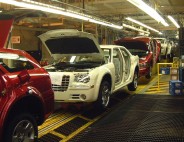Automotive Picks Up Speed
02 Jan, 2013
By Mark Kleszczewski
After facing the biggest recession in decades, a global debt crisis and multiple natural disasters over the past few years, the auto industry in the United States has begun thriving again. Though the automotive market has yet to return to pre-recession levels, aging vehicles, expiring leases and rebounding consumer credit and confidence are expected to increase sales for at least the next two to three years. Advances in technology and standards are also fueling longer-term demand for resources and workers in the sector.
After going through the industry’s restructuring, communities which play host to auto manufacturing are benefitting from today’s upward momentum and in turn supporting investments in infrastructure, plant expansions and specialized workforce training.
Sales Climbing Upward
Although the global auto industry in 2013 is likely to be marked by weakening sales in China and faltering demand in Europe, most foreign and domestic automakers and their U.S.-based suppliers are poised to do well.
Despite ongoing economic headwinds, auto sales increased from 2011 and accounted for more than 40 percent of U.S. GDP growth in the first quarter of 2012, according to the Center for Automotive Research. Most industry analysts estimate 2012 will range from 13.9 million to 14.5 million in new cars sales, while LMC Automotive and Edmunds.com forecast about 15 million new cars to be sold in 2013 — representing a 4 percent increase over the 14.4 million new car sales expected by Edmunds.com in 2012.
Factors spurring the release of pent-up consumer demand include a growing wave of lease expirations, the return of zero-percent APR financing, as well as the growing average age of vehicles in use — which, according to data from Experian — reached a record 11 years in 2012. One-time events such as Hurricane Sandy, which resulted in an estimated loss of at least 266,000 vehicles, are also contributing to the demand for replacement vehicles.
“There is a lot of positive activity in the sector today, though the auto industry was hit hard and suppliers were hit even harder during the recession,” says Mark M. Sweeney, senior principal, McCallum Sweeney Consulting. “The natural disasters in Japan and in Southeast Asia also forced automakers to re-evaluate their global supply chains, resulting in a trend to site more of the supply chain on the same continent where vehicles are sold. The contraction in capacity and the reconsideration of supply chains in North America bode very well for continued, if not increased, supplier facility activity. Although a lot of the plants that went into the Southeast over the last 15 years have some uncertainty around them, they secured enough property to allow for significant future expansions, which points to a positive 2013.
“The industry has also begun integrating more materials like titanium and carbon fiber into vehicles and planning for the new CAFE and MPG standards beyond electric vehicles,” Sweeney continues. “From a marketing standpoint, you’re going to see more about not just how green a car is in terms of miles per gallon, but also how green it’s made. All of that points to changes and investments in retrofitting and building new facilities.”
Factors spurring the release of pent-up consumer demand include a growing wave of lease expirations, the return of zero-percent APR financing, as well as the growing average age of vehicles in use — which, according to data from Experian — reached a record 11 years in 2012.
Persistence Pays Off
Making investments even during tough times has paid off in Ohio, where historical strengths and the current push to source and sell closer to home have led to a significant rebound.
“Although there’s been great expansion in the South, our cluster in the auto industry has survived and is doing much better today,” says Greg Myers, executive director, Wapakoneta Area (Ohio) Economic Development Council. “Everybody here that’s related to auto is currently hiring and seeking more workers. Production is up, book business is up and most of the companies here are reaching capacity at their plants, which is a very good sign.”
“It makes sense today to be close to where your suppliers are. Our proximity to markets is also a big advantage,” Myers adds. “As transportation costs continue to go up, making an automobile and shipping it to nearby markets where you are going to sell it really helps bottom-line profit.”
More than $4 billion has been invested by 93 automotive companies in Ohio from 2006-2012, creating 6,600 jobs, and 3.25 million square feet of industrial space. The state is second in the United States for total Tier 1 automotive suppliers and home to nearly 10 percent of all North American Tier 1 suppliers — totaling 350 companies and more than 56,000 employees.
One of the area’s biggest initiatives comes from the State of Ohio and City of Wapakoneta who, in conjunction with the state’s Job Ready Sites Program, have invested more than $7 million in developing the nearly 800-acre West Central Ohio Industrial Center. The center — one of the nation’s largest rail-served, greenfield industrial parks — is strategically positioned between Chicago, Cleveland, and Cincinnati at the intersection of I-75 and U.S. 33, in proximity to Ohio and Michigan’s R&D community.
Moving south, automotive companies in Georgia benefit from a skilled automotive workforce with decades of experience. The state’s well-established automotive industry leverages Georgia QuickStart — considered to be a model for many other employee training programs across the country — by offering customized training whenever and wherever manufacturers want it. The services are provided free of charge for clients opening or expanding in manufacturing, distribution, customer contact or headquarter operations.
“Assuming that Europe doesn’t collapse, China maintains a decent growth rate and the U.S. doesn’t have any big surprises, we might see more Japanese and European OEM projects in North America. I don’t know if it’d be like it was in the ’90s and early 2000s, but I suspect there’ll be activity to come.” – Mark Sweeney, McCallum Sweeney Consulting
Georgia’s strong automotive culture paved the way for Porsche, Lotus and BBS to locate their North American headquarters in the state, while the QuickStart program proved to be a key ingredient in helping Kia Motors Manufacturing open its first U.S. manufacturing operations in West Point, Ga., back in 2009. Since Kia’s initial launch and subsequent $100 million expansion last February, the company’s $1 billion plant has grown rapidly, creating over several thousand assembly and supply jobs.
Other resources that automakers can take advantage of include a world-class airport, extensive rail and highway systems and the international deepwater ports of Brunswick and Savannah that connect the region to consumers throughout North America and the world.
Another auto industry stronghold is South Carolina, home to 250 automotive manufacturing plants and companies including Proterra Inc., Robert Bosch LLC, Tognum America Inc., ZF, BorgWarner Inc. and Drive Automotive Industries of America Inc. Another significant presence is BMW, which supports 40 suppliers in South Carolina and 170 nationwide. The automaker plans to add 1 million square feet of production space and 1,000 full-time employees over the next three years, bringing BMW Group’s total investment in the state to nearly $6 billion.
“BMW’s plant in Spartanburg is on track to produce more than 300,000 vehicles in 2012, marking another record production year for the factory,” says Sky Foster, department manager, BMW Manufacturing Co. “In 2013, we will continue our $900 million expansion to prepare for additional capacity and the future integration of a new model.”
For automotive suppliers, Aiken and Edgefield counties are positioned two hours south of BMW’s Greenville assembly and less than three hours east of Ford’s Hapeville assembly and GM’s Doraville plant. Bridgestone/Firestone South Carolina, the world’s largest tire manufacturer, is already located in the region. Other automotive suppliers include Aiken Precision Technologies, Rieter Automotive Systems, Shinsho American Corp. and Newman Technology South Carolina Inc.
In Greenville, Clemson University, in conjunction with BMW, Microsoft, IBM, and NASCAR, has created the International Center for Automotive Research (ICAR), making South Carolina a significant center of the country’s automotive research.
Big expansion plans are also underway over in Tennessee, the American hub for Germany’s Volkswagen, which intends to sell 800,000 units annually in the United States by 2018. The company has been enjoying strong demand for its Passat sedan, transforming the United States into a growth hub for VW, which faces difficult conditions in the European market.
To keep pace, VW added a third shift team last year at its factory in Chattanooga – where the Passat is built — boosting employees there to more than 3,300. The increased headcount will allow the plant to produce nearly 180,000 vehicles per year, more than 30,000 units over its original capacity. Though a final decision has not yet been made, VW also expects to use the plant to build a new SUV model, specially designed for American consumers.
Looking Forward
“Assuming that Europe doesn’t collapse, China maintains a decent growth rate and the U.S. doesn’t have any big surprises, we might see more Japanese and European OEM projects in North America,” Sweeney says. “I don’t know if it’d be like it was in the ’90s and early 2000s, but I suspect there’ll be activity to come.”
“We’ve been making automobiles and all the parts that go in them in Ohio for more than a century. We have a workforce who knows how to do it and do it well,” Myers says. “I don’t think anybody expects the bubble that we experienced before the recession to happen again, but as more European manufacturers, especially the Germans, come to the United States to assemble automobiles here, we expect their supply chain to follow. So we’re excited about those opportunities.”
For complete details on the organizations featured in this article, visit:
Center for Automotive Research
Economic Development Partnership (S.C.)
Georgia Department of Economic Development
Northwest Georgia Joint Development Authority
South Carolina Department of Commerce
Wapakoneta Area (Ohio) Economic Development Council
Illustration by watcharakun at Free Digital Photos.net














